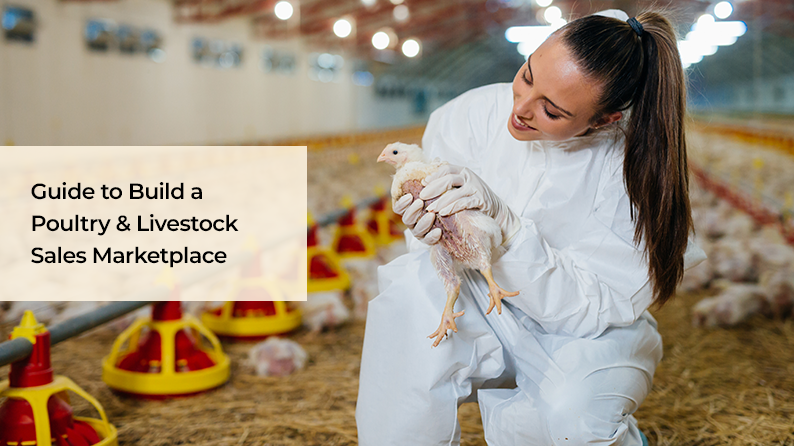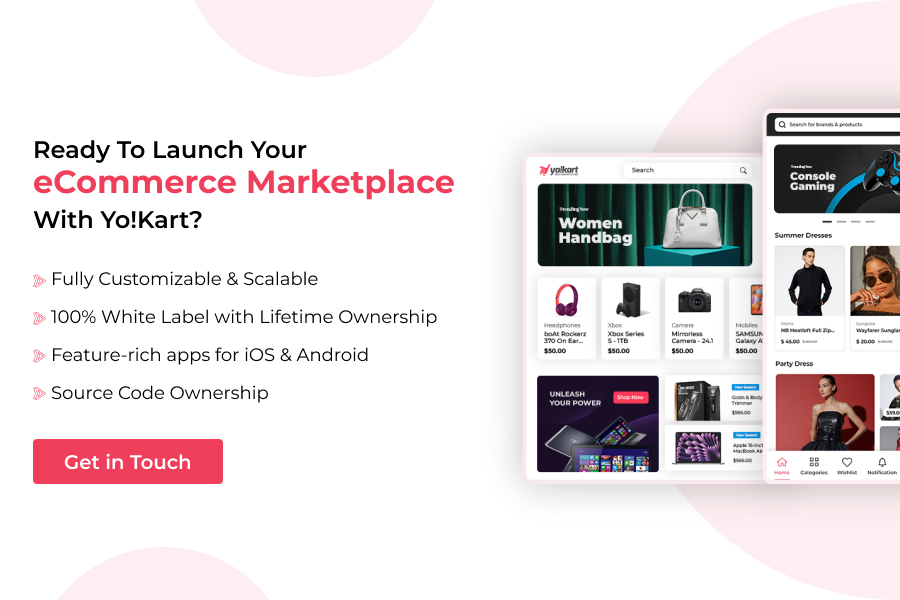Imagine if local farmers could sell their poultry and livestock with the same ease as listing a product on Amazon. In a world where eCommerce is redefining industries, even the most traditional industry, long bound by physical markets and intermediaries (agriculture and livestock), is finally stepping into the digital spotlight.
The agricultural eCommerce industry is estimated to surpass $308.76 billion by 2032 worldwide, opening new doors for farmers, breeders, and agri-entrepreneurs to reach wider markets, optimize operations, and increase profitability.
As consumer demands continue to evolve, traditional methods of selling poultry and livestock are no longer meeting the mark. This changing landscape is opening up new avenues for entrepreneurs to build a farm marketplace for local poultry and livestock sales.
Hence, this blog explores the growing need for a specialized farm marketplace for local poultry and livestock sales and why now is the perfect time to invest in building a farm market platform.
Table of Contents
- What is a Local Poultry and Livestock Sales Marketplace?
- Types of Multivendor Poultry and Livestock Sales Marketplaces
- The Need to Build a Farm Marketplace
- Poultry and Livestock Market Growth: Trends & Key Statistics
- Popular Multivendor Marketplaces for Local Poultry and Livestock Sales
- Benefits of Launching a Farm Marketplace for Local Poultry and Livestock Sales
- Key Features of a Multivendor Poultry and Livestock Sales Marketplace
- Strategic Steps to Build a Farm Marketplace For Local Poultry And Livestock Sales
- Yo!Kart — Best Multivendor Marketplace Software to Launch a Poultry And Livestock Sales Platform
- Wrapping Up
- FAQs
What is a Farm Marketplace for Local Poultry and Livestock Sales?
A local poultry and livestock sales marketplace is a digital platform that connects regional farmers, breeders, and agricultural producers with buyers, wholesalers, retailers, and even meat processing enterprises seeking to purchase animals, poultry products, or livestock-related services.
Unlike conventional brick-and-mortar or informal trading systems, these online marketplaces are structured to enable seamless buying and selling of farm animals and poultry through a centralized, technology-driven interface. At its core, such a marketplace serves as a multivendor eCommerce ecosystem where various sellers can list their livestock, poultry, and related goods, while buyers can browse, compare, negotiate, and purchase based on their preferences, such as availability, quality, breed, health certifications, and pricing.
These platforms facilitate end-to-end transaction management, from product discovery and digital catalogs to payments and logistics. Such platforms thus bridge the gap between rural producers and urban consumers and allow vendors to reach a broader customer base without geographic limitations.
Types of Multivendor Poultry and Livestock Sales Marketplaces
A local poultry and livestock sales marketplace transforms the age-old animal trade into a modern, structured, and technology-enabled commercial experience. Such marketplaces not only improve market access but also support the broader goal of creating transparent and efficient food supply chains in the agriculture sector.
However, there are several types of multivendor marketplaces for local poultry and livestock sales, which are as follows:
- B2C (Business-to-Consumer) Marketplace: Tailored to serve individual customers such as small-scale farmers, homesteaders, or urban buyers interested in fresh poultry and ethically raised livestock. These platforms focus on customer experience, ease of use, and direct-to-consumer delivery models.
- B2B (Business-to-Business) Marketplace: Designed for bulk transactions, B2B poultry and livestock sales marketplaces cater to wholesale and commercial buyers. These marketplaces emphasize request-for-quotes, bulk purchases, certifications, and streamlined procurement processes. Ideal for meat processors, restaurants, and food distribution companies seeking dependable livestock sources.
- Hybrid Marketplaces: Combining B2B and B2C elements, hybrid models offer flexibility to cater to both commercial entities and end consumers.
The Need to Build a Farm Marketplace
The limitations of trading poultry and livestock via offline channels are becoming more apparent, with traditional selling methods getting fragmented and outdated. A dedicated farm marketplace bridges this gap by connecting farmers directly with buyers through a centralized platform, bringing much-needed modernization to the agriculture trade.
Challenges Faced Due to Traditional Selling Methods
The poultry and livestock trade sector still relies heavily on outdated, fragmented methods like in-person auctions, middlemen, and local fairs despite its long-standing importance. These traditional methods are struggling to keep pace as modern buyers increasingly demand traceability, organic certification, and ethically sourced products.
Here are a few challenges faced via traditional methods:
1. Limited Market Reach: Traditional sales channels rely heavily on localized networks, such as physical auctions, farm visits, or regional intermediaries. This restricts the sellers’ ability to connect with a broader & more diverse customer base, resulting in missed opportunities to scale.
2. Dependence on Middlemen: The traditional supply chain is heavily dependent on intermediaries who often control access to markets and buyers. While they may ease transactions, their involvement often inflates costs, reduces farmer margins, and distorts fair market dynamics.
3. Lack of Standardized Prices: Without a unified pricing mechanism, livestock and poultry prices fluctuate based on subjective assessments, regional demand, or bargaining dynamics. As a result, farmers are frequently at a disadvantage, forced to accept suboptimal prices.
4. Quality and Trust Issues: Customers often lack access to verified information on animal health, vaccination records, breed quality, or farming practices. As a result, this information gap leads to reduced buyer trust, repeat sales challenges, and reputational risks for sellers.
5. Logistical & Infrastructure Constraints: Poor transport infrastructure, lack of cold chains, and insufficient veterinary facilities often compromise animal welfare during transit and limit the expansion of trade across wider geographies.
6. Seasonal Volatility and Demand Fluctuation: Livestock and poultry trades are often subject to seasonal variations, festivals, and regional consumption patterns. Hence, traditional sellers struggle to anticipate demand surges or manage surplus inventory effectively without predictive analytics or digital tools.
Poultry and Livestock Market Growth: Trends & Key Statistics
The poultry and livestock sales markets are rapidly evolving as global demand for high-protein foods rises with population growth. Modern technologies are reshaping traditional supply chains, thus creating direct connections between farmers, consumers, and distributors.
According to the latest industry reports,
- The global agriculture market is projected to grow from $15.5 trillion in 2025 to $20.63 trillion by 2029, expanding at a CAGR of 7.9%.
- The poultry market’s value worldwide is forecast to increase from $315.35 billion in 2025 to $401.21 billion by 2032.
- In terms of species, chicken leads with 51.2% of the market share in 2025, followed by geese (23.4%), duck (14.7%), turkey (7.8%), and other poultry items (2.9%).
- The global livestock and meat market is expected to reach approximately $1.6 trillion by 2034.
- Regionally, North America holds the largest portion of the livestock market at 35%, trailed by Europe (27%), Asia Pacific (24%), and Latin America (4%).
- By 2034, the livestock and meat market in the US is projected to reach a value of $406.12 billion.
Popular Multivendor Marketplaces for Local Poultry and Livestock Sales
The digital shift in the agriculture industry has opened new avenues for poultry and livestock farmers to expand their reach beyond traditional, localized markets. In fact, online multivendor poultry and livestock sales marketplaces support diverse business models, from backyard farming to commercial-scale operations.
Here are some noteworthy marketplaces that exemplify innovation and operational excellence in this evolving space:
1. SellMyLivestock
Based in the UK, SellMyLivestock provides farmers with a trusted digital channel to list and purchase animals online. The platform emphasizes traceability, regulatory compliance, and data transparency, core requirements for modern agricultural commerce. With detailed livestock records, photos, and health certifications, it serves as a prime example of how data-driven solutions enhance buyer confidence and streamline procurement.
- Founded In: 2012
- Headquarters: Hampshire, United Kingdom
2. MyPetChicken
Operating as a highly specialized digital platform, MyPetChicken is a niche eCommerce marketplace focused on backyard chicken owners and small-scale poultry keepers in the US. The platform successfully aggregates offerings from multiple hatcheries and suppliers to provide customers with a rich and diverse selection of chicken breeds, hatching eggs, coops, poultry supplies, and related equipment. Though not a full-fledged multivendor platform in the conventional sense, it operates a vendor-inclusive model by sourcing from multiple hatcheries and suppliers.
- Founded In: 2005
- Headquarters: Georgia, United States
3. McMurray Hatchery
A household name in North American poultry farming, McMurray Hatchery is one of the oldest and most trusted hatcheries in the United States. While it is primarily a direct-to-consumer operation, it has evolved to serve as a large-scale poultry sales hub, offering over 100 breeds of chicks, ducks, turkeys, and other fowl. Additionally, the platform integrates biosecurity compliance, bulk order management, detailed breed specifications, health-certified shipments, and educational resources.
- Founded In: 1917
- Headquarters: Iowa, United States
4. Rural365
Offering an intuitive online marketplace for poultry, goats, rabbits, and related farm animals, Rural365 caters to hobby farmers and homesteaders in the US. While its model is more simplified than enterprise-grade platforms, it successfully addresses a valuable segment often overlooked by mainstream agriculture tech, underscoring the market potential within rural consumer bases.
- Founded In: 2018
- Headquarters: South Dakota, United States
5. Cackel Hatchery
A long-established hatchery in the US, Cackle Hatchery has embraced eCommerce to sell poultry, hatching eggs, and supplies online. While it operates primarily as a single-vendor site, it also features collaborations with independent breeders and vendors, effectively functioning as a hybrid multivendor model. The platform allows small breeders to showcase rare or specialty breeds through its wide-reaching channel.
- Founded In: 1936
- Headquarters: Missouri, United States
Launch a Multivendor Poultry & Livestock Marketplace Inspired by Leading Platforms
Benefits of Launching a Farm Marketplace for Local Poultry and Livestock Sales
Launching a farm marketplace for local poultry and livestock trade offers distinct advantages that align with current industry shifts, consumer preferences, and digital transformation in agriculture. As the industry modernizes, such digital marketplaces are increasingly seen as essential infrastructure rather than optional innovations.
Here’s why:
1. Empowers Local Producers and Farmers
A dedicated multivendor marketplace democratizes market access by allowing independent farmers, breeders, and small businesses to list their livestock and poultry without the need for physical market presence. This removes traditional barriers such as middlemen, geographical limitations, and infrastructure constraints, which allows farmers to gain direct exposure to a larger, often regional or national, buyer base.
2. Consolidated Inventory & Increased Variety
By aggregating listings from multiple vendors, a marketplace offers buyers a wider selection of breeds, livestock ages, and price points. This variety enhances the buyer experience and promotes competitive pricing, while also increasing the likelihood of sales conversions for sellers.
3. Increased Operational Efficiency
Digital platforms centralize operations such as order management, logistics coordination, and payment processing, which reduces administrative overhead for individual sellers and enhances overall supply chain efficiency. With centralized tools for transaction management, automated payments, and delivery coordination, sellers can focus more on production and quality, while buyers enjoy a seamless procurement experience.
4. Real-time Analytics and Demand Forecasting
With integrated analytics, digital platforms facilitate the capture of valuable data on customer preferences, seasonal demand trends, and pricing dynamics. These insights enable data-driven decision-making and foster a more resilient, responsive supply chain.
5. Brand Building and Trust Enhancement
A professional, tech-enabled farm marketplace for local poultry and livestock trade helps vendors build credibility and a stronger online presence. Features such as vendor ratings, verified reviews, farm origin tagging, real-time health & vaccination records, and standardized health certifications contribute to greater buyer trust, which is an essential component in the agriculture trade.
Key Features of a Multivendor Poultry and Livestock Sales Marketplace
A multivendor poultry and livestock sales marketplace should serve as a digital infrastructure that streamlines transactions, builds trust, and ensures traceability to compete in the industry. Here are the key features that define a user-centric, scalable farm marketplace for livestock and poultry trade:
1. Vendor Registration and Profile Management: Enable farmers and sellers to register, manage profiles, list products, and maintain their business identities seamlessly.
2. Dedicated Vendor Dashboards: Allow sellers to manage inventory, orders, pricing, shipping, and customer interactions through centralized, intuitive dashboards made just for them.
3. Advanced Product Listing and Categorization: Support detailed product listings with high-quality images, competitive pricing, and brief information on breed, age, weight, health, etc, to help buyers make informed purchasing decisions.
4. Real-time Inventory Management: Enable sellers to efficiently update stock, handle bulk orders, and manage deliveries without operational delays through a centralized control panel.
5. Advanced Search & Filters: Empower customers to locate specific livestock or poultry using filters like breed, price, location, and seller rating, allowing them to quickly find the products that they need.
6. Robust Admin Panel: Enables marketplace owners to facilitate platform governance, user registrations, dispute resolution, and policy enforcement with complete control.
7. Secure Payment Gateways Integration: Integrate secure, trusted payment gateways to your marketplace that also support multiple payment methods such as credit/debit cards, bank transfers, digital wallet, or cash.
8. In-app Communication Tools: Provide built-in messaging and inquiry systems for buyers and sellers to negotiate, verify details, confirm orders, and resolve disputes.
9. Ratings & Reviews: Enable trust building through a transparent ratings & reviews system, enabling buyers to leave feedback in order to maintain transparency and build a reputation-driven marketplace ecosystem.
10. Mobile Responsiveness & App Support: Ensure seamless accessibility with a mobile-first, PWA-enabled platform. Additionally, offer mobile apps to ensure maximum usability and ease of use.
11. Multi-lingual & Multi-currency Support: Cater to regional audiences and cross-border buyers through localized languages and currency options, facilitating trade across international borders.
12. Reports & Analytics Tools: Provides admins and sellers with actionable insights on sales, traffic, inventory movement, and buyer behavior to guide them in making data-driven decisions.
13. Commissions Management: Allows the admin to set commission rates for various products, enabling revenue generation from each transaction conducted on the platform.
14. Marketing & Promotions Tools: Drive traffic and boost product visibility with customizable discount codes, email campaigns, SEO tools, and social media integrations.
15. Regulatory Compliance: Ensure adherence to local and international regulations such as tax regulations and data privacy standards with built-in compliance checks, audit trails, and automated reporting tools.
Strategic Steps to Build a Farm Marketplace For Local Poultry And Livestock Sales
Establishing a farm marketplace for local poultry and livestock sales requires a strategic foundation rooted in market insights, clarity of purpose, and sustainable growth models. Below are the essential steps to building a farm marketplace that businesses should follow:
1. Conduct In-Depth Market Research
Before really jumping into the development, begin with rigorous market research and understand the dynamics of local poultry and livestock trade, including consumer behaviors, demand trends, pricing patterns, and the challenges faced by local farmers and buyers.
Additionally, identify gaps in the existing systems, such as inefficient supply chains, limited market reach, or lack of transparency, and define how your platform will address them.
This thorough research will thus help you validate your marketplace idea, uncover unmet needs, and craft a go-to-market strategy tailored to your target geography and audience.
2. Clearly Define your Niche
The agricultural sector is broad and multifaceted. To achieve stronger market positioning and service clarity, it’s essential to define a specific niche. Will your marketplace serve small-scale backyard poultry farmers, organic livestock producers, or large-scale commercial vendors? A well-defined focus enables the development of tailored service offerings, ensures alignment with relevant compliance standards, and supports a more effective, targeted marketing strategy.
3. Determine the Business and Revenue Model
Selecting a revenue model aligned with your platform goals is critical to long-term success. Some of the common models include:
- Commission: Earn a percentage from every transaction made on the platform.
- Membership Plans: Charge sellers or buyers a recurring fee for access to premium features or exclusive benefits.
- In-App Ad Placements: Generate revenue by offering advertising space within your platform.
- Featured Listings: Charge sellers a fee in exchange for highlighting their products or services for greater visibility on the platform.
- Value-Added Services: Monetize by providing extra services like logistics, analytics, or add-ons.
Finally, evaluate which model works best for you and aligns with your value proposition, vendor expectations, and local market dynamics. You can also combine multiple models to diversify revenue streams and ensure platform sustainability.
Maximize Revenue Generation by Building a Profitable Poultry & Livestock Sales Platform
4. Select Between the Development Approaches
Your marketplace’s technical foundation determines its scalability and performance. There are typically three options: Custom Development, Open-Source Solutions, and Readymade Software, each of which offers distinct advantages. Here’s a brief overview of each:
a. Custom Development: Custom development involves building a platform completely from scratch, tailored specifically to your business requirements. This approach allows for maximum flexibility in design, features, and integrations.
Pros:
- Extensively customizable to meet specific business demands
- Offers complete control over design, features, and integrations
Cons:
- Requires a hefty amount of investment
- Longer development timelines, up to several months or even a year
- Requires a skilled team of developers
- Complex maintenance and support responsibilities
- Risk of scope creep without proper planning
- Higher ongoing costs for updates and scalability
b. Open-Source Software: These solutions are built on community-driven platforms with publicly available source code. These solutions can be modified and enhanced to build fully functional marketplaces. However, they also require an in-house team of skilled developers to modify the source code.
Pros:
- Lower upfront costs with flexible customization
- Large community support and shared plugins/modules
- Avoids vendor lock-in
Cons:
- Technical complexity requires in-house or external development resources
- Compatibility issues with third-party tools or updates
- Varying levels of documentation and support quality
- Greater security risks if updates and patches are neglected
- Limited official support; reliant on community help
- Overhead costs may be increased in the future
c. Readymade Software: Readymade eCommerce marketplace software solutions are pre-built platforms designed for quick deployment. These solutions integrate essential features and integrations from the beginning to build fully functional marketplaces. Most solutions now also offer extensive scalability and customization options to align your platform to your unique business requirements.
Pros:
- Enables rapid deployment with minimal setup effort
- Offers a cost-effective entry into the market
- Provides clear, predictable pricing structures
- Delivers optimized performance out of the box
- Supports high scalability and customization
- Integrates built-in features out of the box
- Built on tried-and-tested frameworks for reliability
Cons:
- Potential vendor lock-in in case of SaaS software
Build a Farm Marketplace with the Most Complete, Industry-Leading Readymade Software
5. Launch and Market Strategically
Once the platform is built, begin with a soft launch to onboard early vendors and buyers. This is because a successful launch hinges on a dual strategy, i.e., platform readiness and market engagement. Use early user feedback to make iterative improvements, and based on that, create a comprehensive marketing strategy that may include:
- Vendor Onboarding: Conduct workshops, webinars, and on-site training for farmers and cooperatives.
- Buyer Acquisition: Leverage content marketing, social proof, verified listings, and transparent seller ratings to build trust.
- Strategic Partnerships: Collaborate with veterinary providers, logistics firms, and local authorities to enhance credibility and operational support.
Yo!Kart — Best Multivendor Marketplace Software to Launch a Poultry And Livestock Sales Platform
As the agriculture and livestock sectors increasingly shift towards digital commerce, the need for a reliable, scalable marketplace solution has become paramount.
Yo!Kart emerges as a purpose-built multivendor eCommerce platform tailored to launch scalable online marketplaces. Designed to meet the complexities of niche commerce, Yo!Kart offers a blend of flexibility, domain-specific features, and enterprise-grade stability to build a farm marketplace for local poultry and livestock sales.
Yo!Kart comes with a suite of rich pre-integrated features that significantly reduce the friction of managing diverse vendor operations while providing a user-centric shopping experience. Additionally, the software is built to handle high transactions, increasing traffic, and complex order flows conveniently without compromising performance.
Here’s why you should choose Yo!Kart:
- 100% White Label
- Self-hosted Solution with One-Time Payment
- Lifetime License, No Recurring Charges
- Customizability for Niche Needs
- Tailored Multivendor Architecture
- Highly Scalable and Secure
- Mobile-Ready & SEO-Optimized
- 1 Year of Free Technical Support
More importantly, Yo!Kart has also served clients in the agriculture sector by launching high-performing marketplaces. Here are some of them:
- NPK Marketplace – US-based Sustainable Architecture Marketplace
- Rexporta – B2B Hardware Marketplace for Agriculture & Homeware Tools
Click here to check Yo!Kart’s client portfolio
Schedule a One-on-One Demo Session to Know More About Yo!Kart
Wrapping Up
Addressing the longstanding inefficiencies in the traditional trade, the transition of the agriculture and livestock industry into a digital space marks a pivotal shift in how producers, vendors, and consumers interact. Businesses can foster transparency, efficiency, and wider market access by aggregating local farmers, breeders, and suppliers onto a single platform while meeting the consumer demand for traceability and convenience. Hence, with a multivendor marketplace software like Yo!Kart, businesses can readily deploy a tailored, scalable platform that connects rural producers to broader markets, enhances revenue streams, and drives long-term sustainability.
FAQs
Q 1. What is a farm marketplace for local poultry and livestock sales?
Ans. A multivendor local poultry and livestock sales marketplace is an online platform where multiple independent sellers, such as farmers, livestock breeders, and poultry producers, can list and sell their animals or related products to buyers looking to purchase poultry and livestock. Customers can browse through various sellers, compare prices, and make purchases directly through the platform. Each vendor manages their own listings, inventory, and orders, while the marketplace owner facilitates transactions, payments, and logistics.
Q 2. How much does it cost to build a local poultry and livestock sales marketplace?
Ans. The cost to build a poultry and livestock sales marketplace varies based on the chosen development approach. While a custom-built platform may take anywhere from $10,000 – $500,000, a readymade software solution reduces this cost by up to 5 to 10 times. For instance, Yo!Kart’s white packages start from just $999, ensuring affordability at every touchpoint.
Q 3. How much time does it take to build a farm marketplace for local poultry and livestock sales?
Ans. The development timeline varies based on your development approach. Building a marketplace via custom development may take up to several months to over a year to launch the platform. On the contrary, by utilizing a readymade software, you can launch the marketplace in as little as a few days, depending on design and customization needs.
Q 4. How can Yo!Kart help in building a farm marketplace for local poultry and livestock sales?
Ans. Yo!Kart is a turnkey, self-hosted multivendor eCommerce marketplace software that allows you to build a farm marketplace quickly and cost-effectively across several niches. Backed by industry-specific features and adaptable architecture, the software can be easily customized to build a local poultry livestock trade marketplace. Additionally, the software is highly secure and scalable to launch a marketplace that can expand easily without compromising performance.
Q 5. How do I market a multivendor local poultry and livestock sales marketplace?
Ans. A strong focus on community engagement and trust-building can be key to growing your platform. Here are the marketing strategies to effectively market your platform:
- Optimize local SEO and Google Business listings to boost regional visibility.
- Run targeted social media campaigns to attract users on the platform.
- Partner with hatcheries and vet clinics to expand reach and build trust.
- Launch referral programs and seller incentives to drive vendor onboarding.
- Promote the marketplace at agri-fairs, community events, and farmer meetups.




